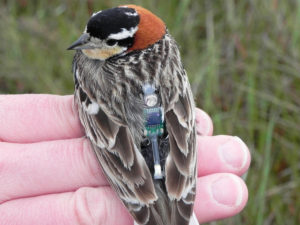The Motus Tracking System
Tracking migratory birds and at-risk species as they move through or nest in Montana.
What is MOTUS: The Motus Wildlife Tracking System (www.motus.org) is an international collaboration that uses miniaturized radio transmitters to track birds, bats and even insects across Canada, The United States, Mexico and Central America to gain a better understanding of migrations and movements. This data also provides researchers with a better understanding of critical flyways and habitat so we can better protect migratory and nomadic populations.
Currently, there are close to 50 receiving stations (towers) in Montana. The towers can be fixed or movable and they look like old school TV antennas. The objective is to create radio telemetry “fences”; one across Montana’s Hi-line and another along the Yellowstone River extending over to Dillon.
The American Bird Conservancy is a national partner in the Motus network, and their representative reached out to SAS to see if we would like to partner with them and Montana Fish, Wildlife and Parks (MFWP) to help plug a hole in the southern fence from Paradise Valley over to the Jefferson River.
Thanks to our generous donors via a successful Give Big campaign in 2025, we raised enough money to construct three receiving stations and create a tagging, maintenance and repair fund to address ongoing efforts.
One receiving station will be located near the Indreland Audubon Wetland Preserve to help collect data for the wetland and along the East Bozeman drainage. Another tower is located at Missouri Headwaters State Park, an Important Bird Area (IBA) at the confluence of the Gallatin, Madison and Jefferson Rivers. These locations will provide endless educational opportunities for the public to engage in science and conservation happening right here in our valley and our region; including opportunities to track the movements of our wetland migrants on the open source Motus website (Motus.org)!
FAQ’s
Why is this needed? In recent decades over 3 billion birds have been lost due to a variety of circumstances. One third of North America’s bird species are now at risk of extinction. The Cornell Lab of Ornithology now categorizes certain bird species as threshold and tipping point species that need our immediate attention to prevent species loss. The Motus Wildlife Tracking System provides vital information to researchers to help us support the systems and habitats that birds need.
What is the difference between tagging and banding? Banding is the traditional way of tracking birds that use coded bands to help provide point-to-point information in a bird’s life cycle. Tags are miniaturized radio transmitters that emit signals that are picked up by receiving stations. The technology of the tags has reached a point where they are small enough to be used on small birds and even insects. They have been used successfully on Monarch Butterflies and dragon flies.

What are the advantages of tagging versus banding? In short, more information, and more real-time information. Banding provides point-to-point information, while the tagging and tracking system can help fill in the movement information between nesting, staging and wintering areas. Tags and bands do not affect breeding or an other important functions of the bird. The tags also fall off the bird after about 9 months so they are not permanent additions.
